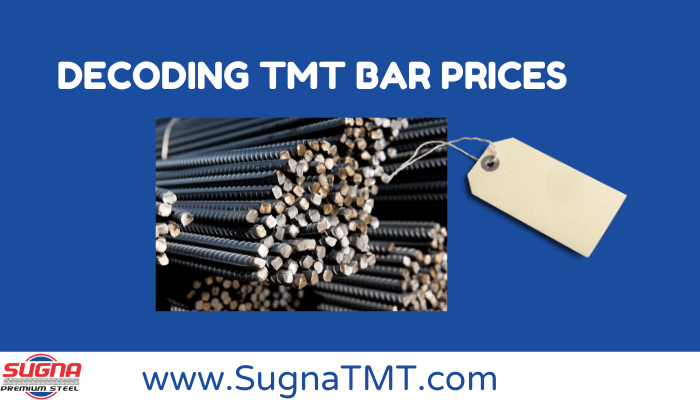TMT bars, or Thermo-Mechanically Treated bars, are a critical component in construction, providing strength and reinforcement to concrete structures. However, understanding the factors that influence TMT bar prices can be complex. In this article, we’ll delve into the various factors that contribute to TMT bar pricing, helping you decode the intricacies of this essential construction material.
Decoding TMT Bar Prices

Raw Material Costs
Steel Prices
The primary raw material used in TMT bar production is steel. Fluctuations in steel prices can have a significant impact on TMT bar costs. Factors such as global demand, supply chain disruptions, and trade policies can influence steel prices, leading to fluctuations in TMT bar prices.
Scrap Metal Prices
Scrap metal is another key input in TMT bar manufacturing. The availability and cost of scrap metal can vary based on factors such as recycling rates, industrial activity, and economic conditions. Changes in scrap metal prices can affect the overall production cost of TMT bars, ultimately influencing market prices.
Manufacturing Process
Production Efficiency
The efficiency of the manufacturing process plays a crucial role in determining TMT bar prices. Factors such as technological advancements, energy efficiency, and economies of scale can impact production costs. Manufacturers that invest in state-of-the-art equipment and streamlined processes may be able to offer competitive prices to consumers.
Quality Standards
Maintaining stringent quality standards throughout the manufacturing process can contribute to higher TMT bar prices. Manufacturers that adhere to international quality certifications and implement rigorous quality control measures may command a premium for their products. However, the assurance of superior quality and performance may justify the higher cost for customers seeking reliability and durability in construction materials.
Market Dynamics
Supply and Demand
Like any commodity, TMT bar prices are influenced by supply and demand dynamics. Increased demand for construction projects, infrastructure development, and urbanization can drive up TMT bar prices due to higher consumption. Conversely, periods of economic downturn or decreased construction activity may lead to oversupply and downward pressure on prices.
Regional Variations
TMT bar prices can vary regionally based on factors such as transportation costs, local market conditions, and regulatory environments. While prices may be relatively uniform in highly competitive markets, remote or underserved regions may experience higher prices due to logistical challenges and limited competition.
Brand Reputation and Value-added Services
Brand Recognition
Established brands with a reputation for quality and reliability may command higher prices for their TMT bars. Customers are often willing to pay a premium for products from trusted manufacturers that have a track record of performance and customer satisfaction.
Value-added Services
Some manufacturers offer value-added services such as customization, technical support, and after-sales service, which can justify higher prices. These additional services enhance the overall customer experience and provide added value beyond the product itself.
Conclusion
Deciphering TMT bar prices requires an understanding of various factors, including raw material costs, manufacturing processes, market dynamics, and brand reputation. By considering these factors comprehensively, consumers can make informed decisions when purchasing TMT bars for their construction projects. Whether prioritizing cost-effectiveness, quality, or value-added services, understanding the intricacies of TMT bar pricing is essential in optimizing project outcomes.

